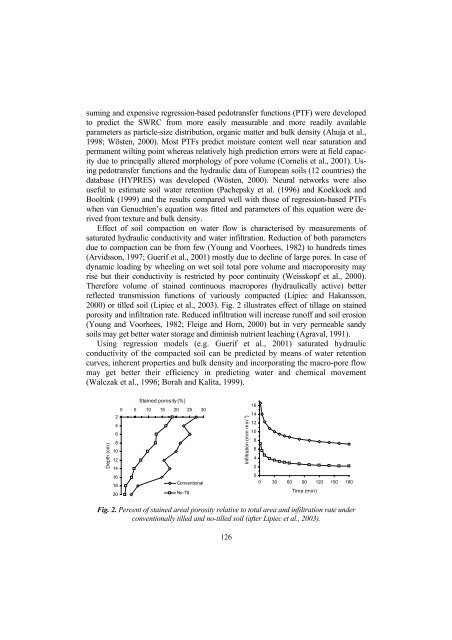soil - Lublin
soil - Lublin
soil - Lublin
You also want an ePaper? Increase the reach of your titles
YUMPU automatically turns print PDFs into web optimized ePapers that Google loves.
suming and expensive regression-based pedotransfer functions (PTF) were developed<br />
to predict the SWRC from more easily measurable and more readily available<br />
parameters as particle-size distribution, organic matter and bulk density (Ahuja et al.,<br />
1998; Wösten, 2000). Most PTFs predict moisture content well near saturation and<br />
permanent wilting point whereas relatively high prediction errors were at field capacity<br />
due to principally altered morphology of pore volume (Cornelis et al., 2001). Using<br />
pedotransfer functions and the hydraulic data of European <strong>soil</strong>s (12 countries) the<br />
database (HYPRES) was developed (Wösten, 2000). Neural networks were also<br />
useful to estimate <strong>soil</strong> water retention (Pachepsky et al. (1996) and Koekkoek and<br />
Booltink (1999) and the results compared well with those of regression-based PTFs<br />
when van Genuchten’s equation was fitted and parameters of this equation were derived<br />
from texture and bulk density.<br />
Effect of <strong>soil</strong> compaction on water flow is characterised by measurements of<br />
saturated hydraulic conductivity and water infiltration. Reduction of both parameters<br />
due to compaction can be from few (Young and Voorhees, 1982) to hundreds times<br />
(Arvidsson, 1997; Guerif et al., 2001) mostly due to decline of large pores. In case of<br />
dynamic loading by wheeling on wet <strong>soil</strong> total pore volume and macroporosity may<br />
rise but their conductivity is restricted by poor continuity (Weisskopf et al., 2000).<br />
Therefore volume of stained continuous macropores (hydraulically active) better<br />
reflected transmission functions of variously compacted (Lipiec and Hakansson,<br />
2000) or tilled <strong>soil</strong> (Lipiec et al., 2003). Fig. 2 illustrates effect of tillage on stained<br />
porosity and infiltration rate. Reduced infiltration will increase runoff and <strong>soil</strong> erosion<br />
(Young and Voorhees, 1982; Fleige and Horn, 2000) but in very permeable sandy<br />
<strong>soil</strong>s may get better water storage and diminish nutrient leaching (Agraval, 1991).<br />
Using regression models (e.g. Guerif et al., 2001) saturated hydraulic<br />
conductivity of the compacted <strong>soil</strong> can be predicted by means of water retention<br />
curves, inherent properties and bulk density and incorporating the macro-pore flow<br />
may get better their efficiency in predicting water and chemical movement<br />
(Walczak et al., 1996; Borah and Kalita, 1999).<br />
Depth (cm)<br />
Stained porosity (%)<br />
0 5 10 15 20 25 30<br />
2<br />
4<br />
6<br />
8<br />
10<br />
12<br />
14<br />
16<br />
Conventional<br />
18<br />
20<br />
No-Till<br />
Infiltration (mm min -1 )<br />
16<br />
14<br />
12<br />
10<br />
8<br />
6<br />
4<br />
2<br />
0<br />
0 30 60 90 120 150 180<br />
Time (min)<br />
Fig. 2. Percent of stained areal porosity relative to total area and infiltration rate under<br />
conventionally tilled and no-tilled <strong>soil</strong> (after Lipiec et al., 2003).<br />
126

















